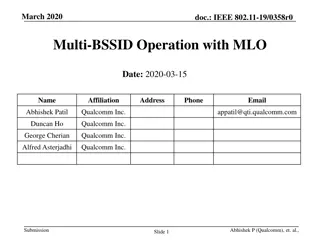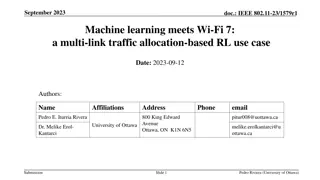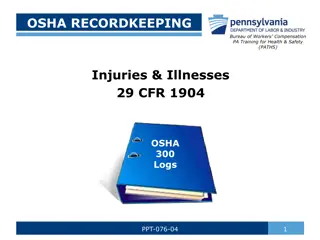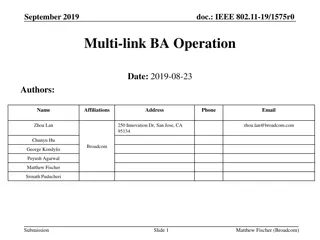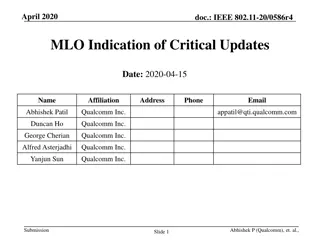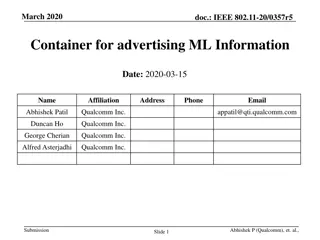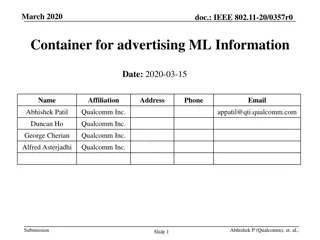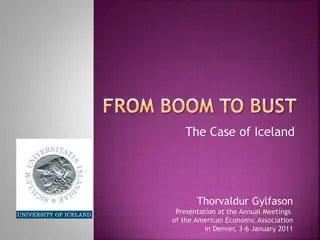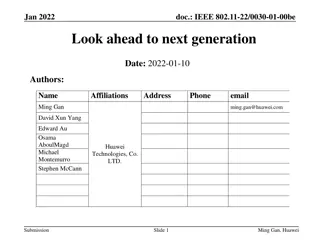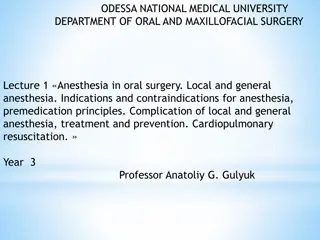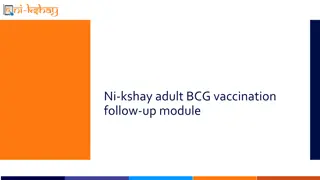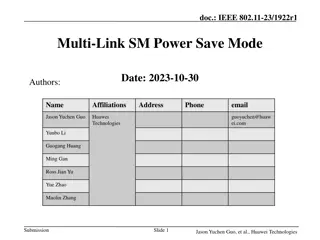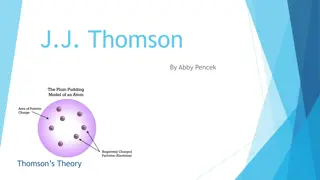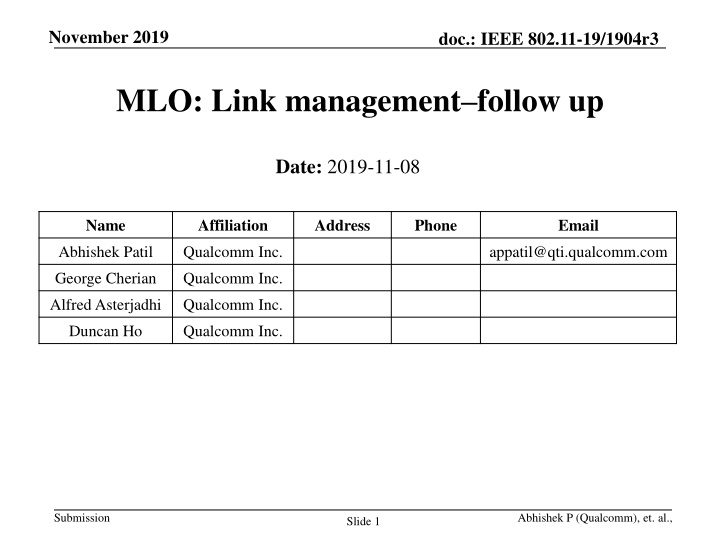
IEEE 802.11-19/1904r3 Link Management Overview
"Explore the November 2019 document focusing on IEEE 802.11-19/1904r3 link management, including discussions on multi-link operation benefits, TID-to-Link mapping, and considerations on power-saving mechanisms for non-AP MLD. Discover steps involved in link setup, multi-link TID-Link mapping procedure, and more."
Download Presentation

Please find below an Image/Link to download the presentation.
The content on the website is provided AS IS for your information and personal use only. It may not be sold, licensed, or shared on other websites without obtaining consent from the author. If you encounter any issues during the download, it is possible that the publisher has removed the file from their server.
You are allowed to download the files provided on this website for personal or commercial use, subject to the condition that they are used lawfully. All files are the property of their respective owners.
The content on the website is provided AS IS for your information and personal use only. It may not be sold, licensed, or shared on other websites without obtaining consent from the author.
E N D
Presentation Transcript
November 2019 doc.: IEEE 802.11-19/1904r3 MLO: Link management follow up Date: 2019-11-08 Name Affiliation Address Phone Email Abhishek Patil Qualcomm Inc. appatil@qti.qualcomm.com George Cherian Qualcomm Inc. Alfred Asterjadhi Qualcomm Inc. Duncan Ho Qualcomm Inc. Submission Abhishek P (Qualcomm), et. al., Slide 1
November 2019 doc.: IEEE 802.11-19/1904r3 Overview Past contributions [1, 2, 4] have discussed the benefits of multi-link operation and have proposed a unified framework to support packet-level aggregation and dynamic transfer of a TID between links Other presentation have proposed a single association for multi-link setup [1, 2, 3, 8] Contributions [3, 5, 6] suggested the concept of link enablement and TID-to-link mapping This contribution continues discussion on link management Submission Slide 2 Abhishek P (Qualcomm), et. al.,
November 2019 doc.: IEEE 802.11-19/1904r3 Steps involved in link management 1. Link setup Involves capability exchange, multi-link association, link configuration Exchanged parameters are valid through the context and duration of the ML association Initiated by a non-AP MLD 2. Multi-link TID-Link mapping procedure Established for each TID flow Dynamic (i.e., remapping) Could change when a TID flow is started/terminated or other criteria Either AP or non-AP MLD could initiate (re)mapping 3. Power-save and Link expansion Non-AP MLD can transition to doze state on a link to conserve power (e.g., due to inactivity on that link) Can use existing PS Poll/APSD trigger or upon receiving EOSP from AP AP MLD can request wake up of dozing link(s) to expand to additional links quickly Can use new signaling Submission Slide 3 Abhishek P (Qualcomm), et. al.,
November 2019 doc.: IEEE 802.11-19/1904r3 TID-to-Link Mapping Identifies the link(s) over which frames belonging to a TID can be transmitted This could be a subset of links that are set up between the two entities during the multi-link association step A link is enabled when at least one TID maps to it Mapping could be performed during or after multi-link association The mapping can be updated later via mgmt. signaling Either peer could trigger an update (remapping) Based on start of a new TID flow, or termination of an existing flow, or other criteria (such as changes in channel condition or load balancing) Submission Slide 4 Abhishek P (Qualcomm), et. al.,
November 2019 doc.: IEEE 802.11-19/1904r3 Considerations on Power-save A non-AP MLD consumes power when monitoring a link Therefore the framework must provide a mechanism for the non-AP MLD to save power To achieve this, a non-AP MLD is not required to monitor more than one link during idle or light traffic conditions [7] The non-AP MLD monitors a default link Default link identified by TBD means The STA instances on other links may enter doze state An AP MLD is expected to monitor all the mapped links; therefore, the non-AP MLD can transmit UL to its associated AP MLD on any of the mapped link(s) However, since a STA of a non-AP MLD may be in doze state, the AP MLD needs to provide an indication to the non-AP MLD when it intends to service it on a link other than the default link. Submission Slide 5 Abhishek P (Qualcomm), et. al.,
November 2019 doc.: IEEE 802.11-19/1904r3 Per-link power-save Each STA instance can utilize existing PS schemes (such as EOSP=1 or MORE=0 from AP or PM=1 during inactivity from non-AP) to transition to doze or awake state STA instance on default link continues to monitor beacon Default link identified by TBD mechanism Submission Slide 6 Abhishek P (Qualcomm), et. al.,
November 2019 doc.: IEEE 802.11-19/1904r3 Cross-link Wake Up An AP MLD signals wake-up of other link(s) via signaling on the default link. The signaling could be carried in an individually addressed or a group addressed frame: Individually addressed frame: Similar to OM transition changes (i.e., takes effect at the end of the current TXOP) Possible with A-Control-level signaling to indicate wake-up on another link Group addressed frame: Beacon indicates the link(s) on which the AP MLD is requesting the non-AP MLD to be in awake state Per-link AID scheme could aid signaling of wake-up via (existing) TIM element Non-AP STA(s) on non-default link(s) can signal (e.g., PS-POLL) awake state Alternatively, signaling on default link could indicate awake state of other link(s) Submission Slide 7 Abhishek P (Qualcomm), et. al.,
November 2019 doc.: IEEE 802.11-19/1904r3 Summary This contribution provides a clear delineation between link mapping and power-states of each link Introduces the concept of a default link where the non-AP MLD, at the least, monitors APs beacons Each non-AP STA instance performs transition to doze state based on activity on its affiliated link Introduces cross-link wake-up signaling Submission Slide 8 Abhishek P (Qualcomm), et. al.,
November 2019 doc.: IEEE 802.11-19/1904r3 SP #1 Do you support that the 802.11be amendment shall define signaling to map and dynamically remap a TID to one or more setup links? Note: Exact signaling TBD Y: N: A: Submission Slide 9 Abhishek P (Qualcomm), et. al.,
November 2019 doc.: IEEE 802.11-19/1904r3 SP #2 Do you agree that a STA of a non-AP MLD maintains its own power-state/mode on a link to which at least one TID is mapped? Y: N: A: Submission Slide 10 Abhishek P (Qualcomm), et. al.,
November 2019 doc.: IEEE 802.11-19/1904r3 SP #3 Do you agree that an AP MLD can recommend a non- AP MLD to use one or more links? The AP s indication could be carried in a broadcast or a unicast frame Y: 42 N: 0 A: 19 Submission Slide 11 Abhishek P (Qualcomm), et. al.,
November 2019 doc.: IEEE 802.11-19/1904r3 Motion Move to add the following text to the 11be SFD: An AP MLD can recommend a non-AP MLD to use one or more enabled links? The AP s indication could be carried in a broadcast or a unicast frame Y: N: A: Submission Slide 12 Abhishek P (Qualcomm), et. al.,
November 2019 doc.: IEEE 802.11-19/1904r3 References [1]: 11-19-0773 Multi-link Operation Framework (Po-Kai Huang - Intel) [2]: 11-19-0823 Multi-Link Aggregation (Abhishek Patil - Qualcomm) [3]: 11-19-0821 multiple band discussion (Liwen Chu - Marvell) [4]: 11-19-1082 Multi-link Operation: Dynamic TID Transfer (Abhishek Patil - Qualcomm) [5]: 11-19-0979 Multi-link Operation Follow-up (Yongho Seok - Mediatek) [6]: 11-19-1528 Multi-Link Operation - Link Management (Abhishek Patil - Qualcomm) [7]: 11-19-1526 Multi-Link Power-save (Abhishek Patil - Qualcomm) [8]: 11-19-1525 Multi-Link Association (Abhishek Patil - Qualcomm) Submission Slide 13 Abhishek P (Qualcomm), et. al.,
November 2019 doc.: IEEE 802.11-19/1904r3 APPENDIX Submission Slide 14 Abhishek P (Qualcomm), et. al.,
November 2019 doc.: IEEE 802.11-19/1904r3 Example of wake-up signaling in an individually addressed frame Each PPDU can carry different A-Control subfields Beacon A-Control signaling expansion to link 2 Data (default) AP entity Link 1 ACK A-Control Non-AP entity EOSP = 1 AP entity Link 2 Non-AP entity Non-AP STA in doze state Optional signaling to indicate awake state Non-AP STA in awake state Non-AP STA in doze state Submission Slide 15 Abhishek P (Qualcomm), et. al.,
November 2019 doc.: IEEE 802.11-19/1904r3 Example of wake-up signaling in a group addressed frame Beacon Beacon Beacon [TIM 24(1), 25(1)] Data [TIM 24(1), 25(0)] [TIM 24(0), 25(0)] AP entity Link 1 Signaling indicating awake state (could apply for multiple links) ACK Non-AP entity (AID24) [default] Beacon EOSP = 1 Beacon [TIM 24(1), 25(1)] [TIM 24(1), 25(0)] AP entity Link 2 Signaling indicating awake state (could apply for multiple links) Non-AP entity (AID25) Non-AP in doze state on link 2 Non-AP in awake state on link 2 Non-AP in doze state on link 2 Submission Slide 16 Abhishek P (Qualcomm), et. al.,




